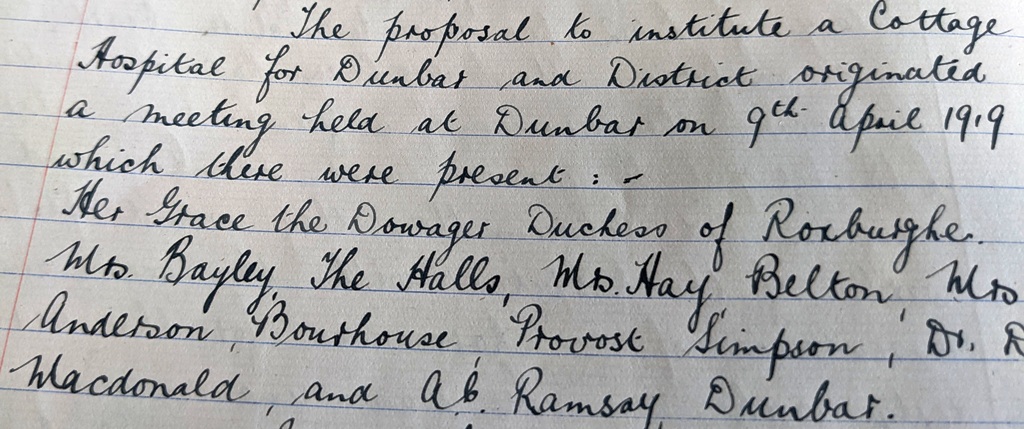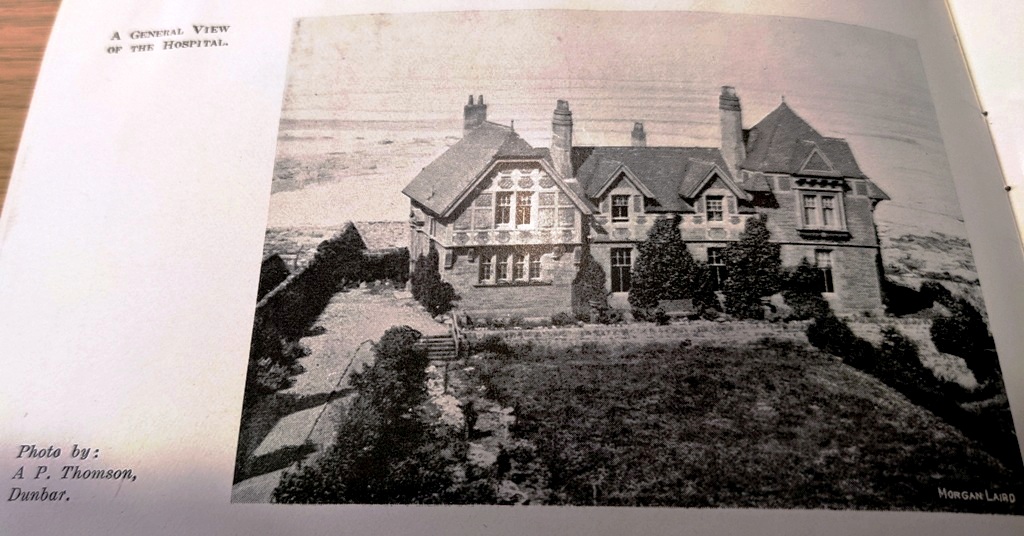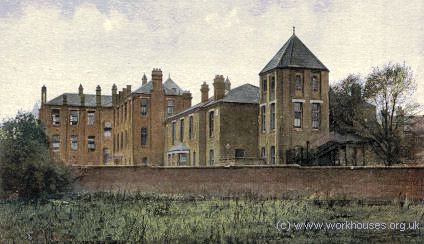December 2022
This month features a talk given to the Society by Dr James Herring. It is the first of two talks he will give on Dunbar Cottage Hospital. The first talk focused on the 1920s, with particular emphasis on the hospital’s move from the old Battery Hospital to Yorke Lodge in the 1920s.

The photo above is of Anne Innes-Ker (neé Spencer-Churchill) married to James Henry Robert Innes-Ker, Marquess of Bowmont and Cessford – became 7th Duke of Roxburghe. She became a Dowager Duchess when her husband died. This lady was one of the key drivers of the early Cottage Hospital and she had been active during WW1 in sending cheerful postcards to troops. The 2nd photo shows an extract from the Minutes of a meeting of the Managers of the Cottage Hospital. Jim Herring studied the minutes – from 1919-1948 when the hospital joined the newly formed NHS – in Edinburgh University Library. The Duchess (auntie of Winston Churchill) became the president of the hospital and used her wealth and local social influence to raise awareness of the hospital as well as funds for its continuance. Mrs Hay of Belton later became the president and Dr Macdonald was also a key driver of the hospital. While most cottage hospital in Britain were led by local influential men, the Dunbar hospital’s leadership came from two strong, determined and socially prominent women.
Cottage hospitals were not viewed as being for everyone, but for the “deserving poor”. One writer in a book on cottage hospitals in 1870 wrote “The class of patients to be admitted are the respectable poor, journeymen etc, not those usually in receipt of parish relief, for whom the union infirmary is provided”. The Union Infirmary was also known as the workhouse and another writer noted that “Union infirmary care should not be better than that of the needy and industrious ratepayer who has neither the money nor the influence to secure prompt and careful attendance”. This meant that the very poor were not viewed as potential cottage hospital patients, who were expected to pay towards their medical treatment, accommodation and food.


The search for a new and more secure building began in the early 1920s when the committee realised that the old Battery Hospital building did not meet the required standards. To raise funds for the new hospital building, a fete was held at Broxmouth House (photo above) in 1925 and this raised £2,202 – over £130,000 today. Although there were numerous stalls at the large fete, it is unlikely that this was sufficient to raise the £2,202, so it may have involved wealthy local people making donations or taking part in an auction. The hospital minutes do not record how the sum was raised. One clue to the wealth of those attending the fete lay in the minutes, which stated that “an entrance for motor cars” was needed. As only very affluent people could afford cars at this time, their attendance at the fete must have guaranteed a large fund being raised. The 2nd photo above shows a Daimler car from the mid 1920s. The caption with the car states “Daimler Vintage Car, Dunbar, near North Berwick, East Lothian, Scotland”. Near North Berwick?

The photo above shows Yorke Lodge and part of its grounds and is taken from a booklet issued by the Cottage Hospital in the late 1920s. The enlarged photo shows the hospital – on East Links Road – with the sea wall behind it and the sea beyond that. This building was a vast improvement on the Battery Hospital, as it was a substantial house which could provide space for wards and hospital staff accommodation. Yorke Lodge was purchased for £2,200 and a further £800 was raised by donations and subscriptions for repairs and installation of an operating theatre. One aspect of the sum paid for the building is that it is c£130,000 in today’s money. This shows that house price inflation is perhaps 5 or 6 times that of other inflation, as a building like this today would certainly cost much more that £650,000. The Haddingtonshire Courier of 1927 noted that, despite poor weather, a substantial crowd attended the opening and “The Countess of Haddington unlocked the main door and declared it open. The hospital is equipped on the most up to date lines, the hospital has an operating theatre”. The hospital was then open for inspection and the Courier noted the great satisfaction of those who went indoors. The area served by the hospital was extended from Dunbar to take in country areas such as Cockburnspath, Oldhamstocks and Tyninghame.



You must be logged in to post a comment.